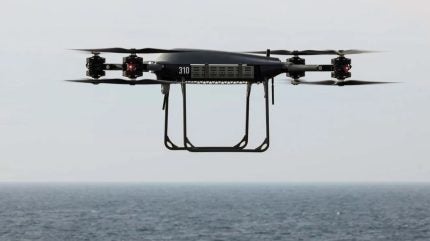
The British Royal Navy is integrating uncrewed aerial vehicles (UAVs) to facilitate logistical operations within its Carrier Strike Group ahead of its deployment to the Indo-Pacific region.
This marks the inaugural use of a UAV fleet to transport essential items such as sustenance, personal parcels, and mechanical components amongst the fleet’s vessels.
The swift adoption and integration of UAV technology reflects the Royal Navy’s commitment to embracing new systems and methodologies at an unprecedented pace, with advancements that would typically span years now being implemented within months.
The drones in question are products of Malloy, a private enterprise, developed through a research and development initiative spearheaded by the UK Ministry of Defence aimed at fast-tracking the adoption of innovative technologies.
BAE Systems Malloy Aeronautics CEO Neil Appleton said: “It’s an exciting moment to see the Royal Navy deploying with our T-150s as an efficient and cost-effective ship-to-ship resupply logistics solution.
“We are proud to contribute to this important deployment and look forward to watching these versatile drones prove their worth during operational duties.”
The HMS Prince of Wales, serving as the group’s flagship, will incorporate an air group that includes nine advanced Malloy T-150 octo-copters capable of remotely delivering goods throughout the task force.
This initiative aims to alleviate the burden on crewed helicopters, allowing them to concentrate on their principal task of safeguarding the strike group during its voyage to Asia.
HMS Prince of Wales will also have up to 24 Royal Air Force F-35B Lightning fighter jets stationed aboard the ship.
Personnel from 700X Naval Air Squadron stationed at Royal Navy Air Station Culdrose will be onboard, with a contingent of 12 sailors tasked with operating the nine UAV systems from three different ships within the group for testing purposes.
700X NAS drone flight commander Matt Parfitt said: “We only got these Malloy systems last August. Since then we’ve had to learn how to fly and maintain them and how to integrate them into the crewed aviation space. That’s an awful lot of regulations and documentation that has to be done, which is a lot of work for us as we prepare to deploy.
“These systems have only really been used over land before, so we’re also having to understand how we can operate and maintain them in the maritime environment.”
HMS Prince of Wales is scheduled to depart from Portsmouth on 22 April 2025, joining a formation of warships, supply vessels, and aircraft off the Cornwall coast before proceeding to the Mediterranean.
It will participate in exercises to bolster European security.
The eight-month deployment, involving around 2,500 Royal Navy personnel and 592 from the Royal Air Force, will see the group navigate through the Indian Ocean, engaging in exercises and port visits with allies such as the US, India, Singapore, and Malaysia.
Dubbed Operation Highmast, the mission will continue with joint exercises including Exercise Talisman Sabre near Australia, training with the Japanese Self Defence Forces, and a port visit to India.
Recently, Prime Minister Keir Starmer pledged to raise defence spending to 2.5% of Gross Domestic Product by 2027.



